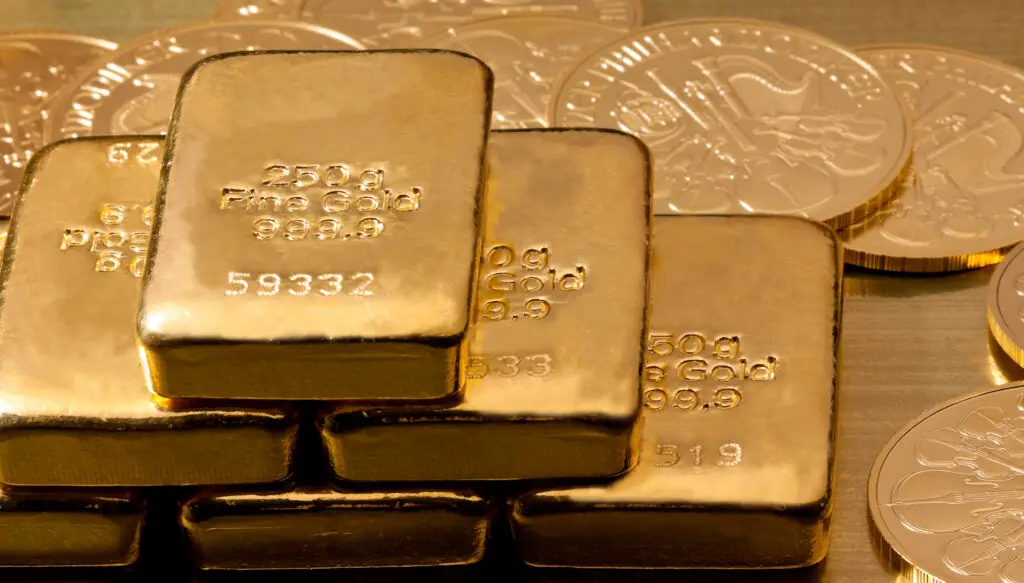As we delve into the vast arena of investments, where trends ebb and flow as fluidly as the tide, there remains an immutable constant — gold. Revered for millennia, this lustrous yellow metal has perpetually served as a symbol of wealth, power, and prestige. This blog post illuminates the various reasons why gold, despite the oscillations of financial markets and evolving asset classes, will never nosedive to a zero price.
Throughout history, gold has proved to be a safe harbor for investors, offering a resolute beacon of security amidst the often tumultuous sea of economic uncertainty. Gold’s proven track record as a robust store of value is unparalleled, making it an indispensable component of any astute investor’s portfolio. However, what truly underpins its enduring allure?
The reasons are manifold. Not only does gold serve as an efficient hedge against inflation and geopolitical instability, but it also offers a tangible, finite resource, distinct from the intangible nature of stocks and cryptocurrencies. The intrinsic value of gold stems from its physical properties and wide array of industrial and decorative uses, hence ensuring its perennial demand.
This blog post will elucidate these aspects and shed light on why investing in gold is not merely a reactionary strategy, but a proactive step towards fortifying financial resilience. As we chart the course through this golden journey, we’ll explore how the perennial allure and inherent value of gold provide a steady, undeniable counterforce to a zero-price scenario.

Reasons Why Gold Won’t Go To Zero
It Has Never Crashed Before
Indeed, throughout history, gold has never plummeted to a zero price, and for good reasons. Let’s delve into the various factors that have kept the gold market steady and resilient, even in the face of economic turbulence.
Intrinsic Value: Gold has intrinsic value, meaning it has worth in and of itself, not merely ascribed by market conditions. This value stems from its unique physical properties, including its malleability, durability, conductivity, and beauty. These attributes have made gold a prized resource across a myriad of sectors, including jewelry, electronics, dentistry, and aerospace.
Finite Resource: Gold is a finite resource, and it is expensive and complex to mine and refine. This inherent scarcity reinforces its value. Even as mining technology has advanced, the extraction of gold remains a difficult process, ensuring that there is always a baseline cost associated with obtaining it, thus preventing its value from plummeting to zero.
Safe Haven Asset: Gold is globally recognized as a “safe haven” asset. Investors typically flock to gold in times of economic uncertainty or market volatility because it tends to retain or even increase its value when other asset classes are suffering. This steady demand helps to keep gold’s price from crashing.
Hedge Against Inflation: Gold is often seen as a hedge against inflation. When fiat currencies lose their purchasing power due to inflation, gold’s value typically rises. This inherent ability to protect wealth from the corrosive effects of inflation has further entrenched gold’s place as a sought-after investment.
Diversification: The inclusion of gold can provide diversification in an investment portfolio because its price movements are often different from other assets. Diversification helps to reduce the overall risk of the portfolio, making gold a valuable addition.
Global Acceptance: Gold is universally accepted as a form of wealth. Unlike national currencies, which are subject to government policies, gold has always been and will always be valuable everywhere.
These factors, working synergistically, have helped gold maintain its worth throughout centuries of economic change and upheaval. While the price of gold can fluctuate, its inherent value and enduring demand create a solid floor beneath which its market price is unlikely ever to fall.
Gold Is Classified As A Tier 1 Asset
In April 2019, the Basel III regulations reclassified gold as a Tier 1 asset for banks. This significant shift in the banking industry transformed the way gold is perceived and used by financial institutions worldwide.
Before this reclassification, gold was considered a Tier 3 asset, meaning that banks could only account for 50% of its market value for capital adequacy calculations. But as a Tier 1 asset, gold is now considered as good as cash. Banks can account for 100% of its market value.
Let’s unpack what this means and why it matters:
Capital Adequacy: Banks need to maintain a certain level of capital to safeguard against potential financial crises or economic downturns. This is termed ‘capital adequacy’. Different assets contribute differently to a bank’s capital adequacy, based on their tiers. As a Tier 1 asset, gold now contributes more significantly to a bank’s capital adequacy.
Risk Weighting: The tier classification system reflects the riskiness of assets. Tier 1 assets are perceived as the least risky and therefore the most ‘liquid,’ i.e., they can easily be sold without a significant change in value. This is important in times of economic stress when banks might need to sell assets to raise cash quickly. By categorizing gold as a Tier 1 asset, Basel III recognizes gold’s reliability and stability as an investment.
Incentive to Hold Gold: By moving gold to Tier 1, the regulations incentivize banks to hold more gold as part of their reserves. It increases the demand for gold by banks, potentially leading to price appreciation.
In summary, the Basel III regulations acknowledge the stability, liquidity, and intrinsic value of gold. As a Tier 1 asset, gold has become an even more essential part of financial systems worldwide, solidifying its position as a bulwark against economic instability.
Is being Bought Up by Central Banks Worldwide
Central banks around the world have been net buyers of gold for more than a decade, underlining their faith in gold’s enduring value. The central banks’ accumulation of gold is driven by a range of strategic economic factors. Let’s delve into why they are bolstering their gold reserves.
Diversification: Central banks hold reserves in a variety of assets, and gold offers them an effective means of diversification. Gold often performs differently than other assets during times of economic turbulence or geopolitical uncertainty, making it an ideal counterbalance in a portfolio.
Independence from the U.S. Dollar: Many central banks aim to reduce their dependence on the U.S. dollar, especially those in countries with strained political relations with the U.S or whose economies are negatively impacted by the dollar’s fluctuations. By increasing their gold reserves, these central banks can fortify their economies against dollar volatility.
Hedge Against Inflation: Similar to individual investors, central banks also view gold as a hedge against inflation. Inflation erodes the purchasing power of fiat currencies, whereas gold tends to maintain or even increase its value in inflationary times.
Confidence and Trust: Gold reserves can signal economic stability and strength, inspiring confidence among a nation’s citizens and international markets. This can be particularly important for countries with emerging or struggling economies.
Gold’s New Status as Tier 1 Asset: The Basel III regulations reclassified gold as a Tier 1 asset, effectively considering it as secure as cash for capital adequacy calculations. This further incentivizes central banks to add more gold to their reserves.
Historically, countries like Russia, China, Turkey, and Kazakhstan have been significant purchasers of gold. More recently, countries like Poland and Hungary have also made large gold purchases, signalling a broader trend towards gold accumulation by central banks. By buying up gold, central banks worldwide are reinforcing their financial fortitude and contributing to the sustained demand and value of this timeless asset.
It Is A Physical Asset (Not Digital)
In an era of burgeoning digital assets and currencies, gold stands as a timeless and tangible counterpoint. Its physical nature provides several unique benefits that make it an appealing investment. Let’s explore some key reasons why gold’s physicality contributes to its enduring allure as an investment:
Tangibility: Gold is a tangible asset – you can touch, hold, and store it physically. This tangibility brings a sense of security that digital or intangible assets cannot offer. It’s not subject to hacking, digital theft, or technological glitches. In extreme circumstances, such as a total grid failure, gold would still maintain its value while digital assets could become inaccessible or worthless.
Inherent Value: Gold carries an inherent value due to its physical properties and myriad uses across industries like electronics, dentistry, and jewelry. Its demand isn’t based solely on financial markets but also on its practical uses, which further reinforces its worth.
Immune to Inflation: Physical gold cannot be reproduced or inflated like digital or fiat currencies. Its scarcity provides a hedge against inflation, protecting the purchasing power of your wealth. While governments can print more money or mine more digital currencies, the amount of gold on Earth remains relatively constant.
Storage of Wealth: As a physical asset, gold can be stored and saved for generations. It doesn’t decay or corrode, making it a durable and long-lasting store of wealth. This makes gold an excellent investment for long-term wealth preservation.
No Counterparty Risk: When you hold physical gold, there’s no counterparty risk. Unlike digital assets or stocks, where your investment may be tied to the performance of a company or the stability of a digital platform, gold’s value doesn’t rely on someone else’s ability or obligation to deliver on a contract.
Privacy: Gold can be bought and held anonymously, offering a degree of privacy that digital transactions cannot.
Universally Accepted: Gold is a universal form of wealth that is accepted worldwide. Its value isn’t tied to any particular digital platform, government, or financial institution.
Investing in gold can provide balance and stability in a diversified portfolio. Its physical nature brings unique benefits, offering a measure of security, stability, and privacy that digital assets cannot match. Despite the rise of the digital age, gold’s physical allure remains as compelling as ever.
It Has Been Going Up In Price Since The 1970s
End of Bretton Woods System: In 1971, U.S. President Richard Nixon ended the backing of the gold to the US Dollar, effectively finishing the Bretton Woods system. This event, known as the ‘Nixon Shock,’ led to the floating of gold prices in the open market, which led to significant price increases.
Economic Crises: Gold prices often surge during times of economic instability or uncertainty as investors seek safe haven assets. Notable examples include the 2008 financial crisis and more recently, the COVID-19 pandemic.
Inflation and Monetary Policy: Over the past century, inflation has generally trended upwards, leading to decreases in the purchasing power of fiat currencies. As a hedge against inflation, gold’s value has correspondingly appreciated. Moreover, the expansionary monetary policies implemented by central banks, particularly in the wake of economic crises, often stoke fears of inflation and spur demand for gold.
Growing Demand: There’s also been increasing demand for gold from emerging markets like India and China, particularly for use in jewelry. Furthermore, central banks worldwide have been net buyers of gold for over a decade, adding to demand pressures.
Gold as a Tier 1 Asset: The Basel III regulations, implemented in 2019, recognized gold as a Tier 1 asset, which could potentially boost its demand and price.
These factors, among others, have contributed to the general upward trend of gold prices since the 1970s. However, it’s crucial to remember that while the long-term trend may be upward, there can be significant fluctuations in the short term. As with all investments, it’s essential to thoroughly research and carefully consider your options when investing in gold.

